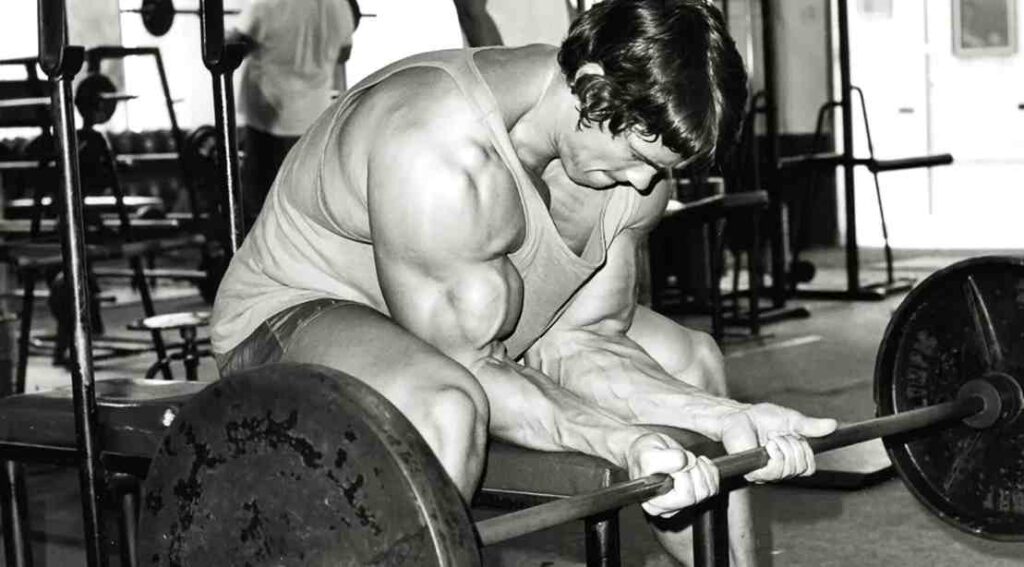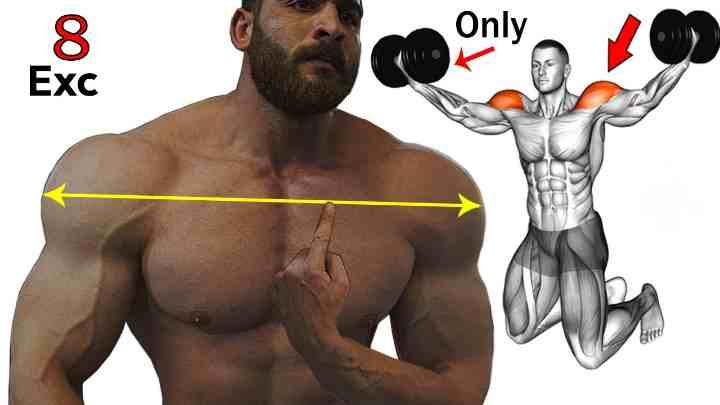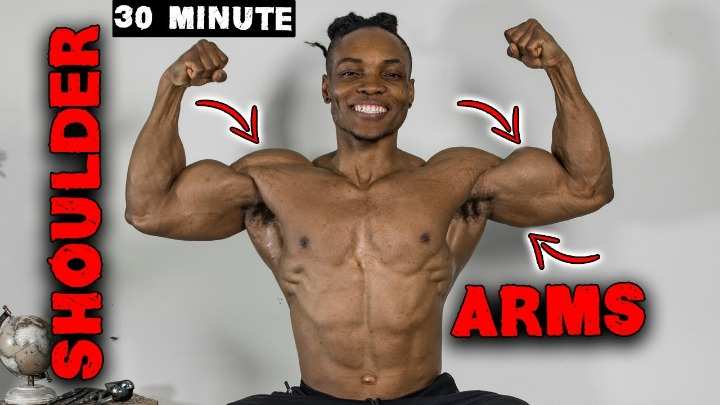When it comes to building strong, sculpted shoulders, the Overhead Press and the Military Press are two go-to exercises that often come up in conversation. Both are staples in strength training programs, beloved by bodybuilders, powerlifters, and fitness enthusiasts alike. But what sets these two exercises apart? Why might you choose one over the other, and how can each fit into your overall fitness goals?
In this article, we’ll delve into the nuances of the Overhead Press and the Military Press, exploring their unique benefits, techniques, and how they stack up against each other. Whether you’re looking to enhance your shoulder development, improve your lifting technique, or simply understand the differences, we’ve got you covered.
Introduction to Overhead Press and Military Press
The Overhead Press, sometimes referred to as the “press”, is a weight training exercise that has been practiced for centuries. It was a key component of old-school strongman routines and was even included in the Olympics as one of the main lifts until 1972. The exercise involves lifting a weight straight overhead to full arm extension while standing, engaging the muscles of the shoulders, upper chest, triceps, and core. The Overhead Press is highly regarded in strength training due to its ability to build upper body strength and improve stability.
The Military Press is a variation of the Overhead Press and gets its name from its popularity in the military as a measure of upper body strength. The key difference lies in the stance – in a Military Press, the feet are positioned close together, mimicking the ‘attention’ stance in the military. This stricter form increases the demand on the core and stabilizing muscles, making it a more challenging exercise. The Military Press is an excellent tool for developing shoulder strength and improving posture.
SHOP FOR THE ADJUSTABLE DUMBBELL SET ON AMAZON
Both the Overhead Press and the Military Press are fundamental exercises in strength training. They not only help in building muscle and strength in the upper body, but also improve core stability and functional fitness. Understanding these exercises, their origins, and their role in strength training can provide valuable insights into effective workout programming.
Muscles Worked
Both the Overhead Press and the Military Press are compound exercises, meaning they engage multiple muscle groups at once. Let’s break down the primary and secondary muscles involved in these exercises:
Overhead Press:
- Primary Muscles: The primary muscles worked in the Overhead Press are the deltoids (shoulder muscles). This includes all three heads of the deltoid muscle – the anterior (front), lateral (side), and posterior (rear).
- Secondary Muscles: The secondary muscles involved include the triceps brachii (the muscles at the back of your upper arm), the upper pectorals (chest muscles), and the trapezius (a large muscle that extends down the back of the neck and upper spine). Additionally, the core muscles (including the abs and lower back) are engaged to stabilize the body during the lift.
Military Press:
- Primary Muscles: Similar to the Overhead Press, the primary muscles worked in the Military Press are the deltoids. Due to the stricter form, the Military Press may place a slightly greater emphasis on the anterior deltoids.
- Secondary Muscles: The secondary muscles involved are also the triceps brachii, upper pectorals, and trapezius. However, due to the ‘attention’ stance with feet together, the Military Press requires greater engagement of the core muscles for stability.
SHOP FOR THE WEIGHT PLATES ON AMAZON
Understanding these muscle activations can help you choose the right exercise based on your fitness goals and ensure balanced shoulder development and overall upper body strength.
Technique and Form
Correct Form and Technique for the Overhead Press
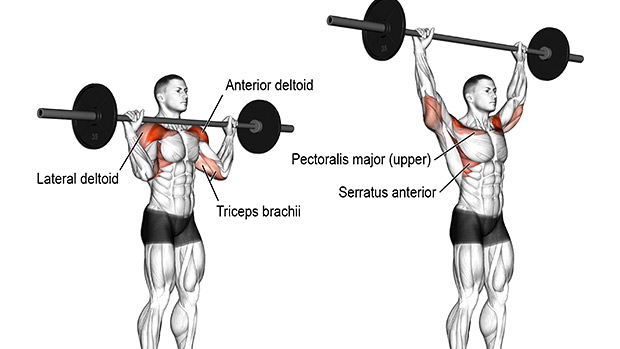
- Setup: Stand with your feet shoulder-width apart. Grip the barbell with hands slightly wider than shoulder-width.
- Grip and Position: Keep your wrists straight and elbows slightly in front of the bar. The bar should rest on your upper chest.
- Bracing: Engage your core and glutes to stabilize your body.
- Pressing: Push the barbell straight overhead. As the bar passes your forehead, slightly tilt your head back, then bring it forward once the bar clears.
- Lockout: Fully extend your arms at the top, with the barbell over the middle of your foot. Avoid shrugging your shoulders.
- Lowering: Control the descent, bringing the barbell back to your upper chest while maintaining a stable core.
Key Points:
- Maintain a neutral spine throughout the movement.
- Avoid excessive leaning or arching of the lower back.
- Use a full range of motion, pressing the bar overhead completely.
Correct Form and Technique for the Military Press
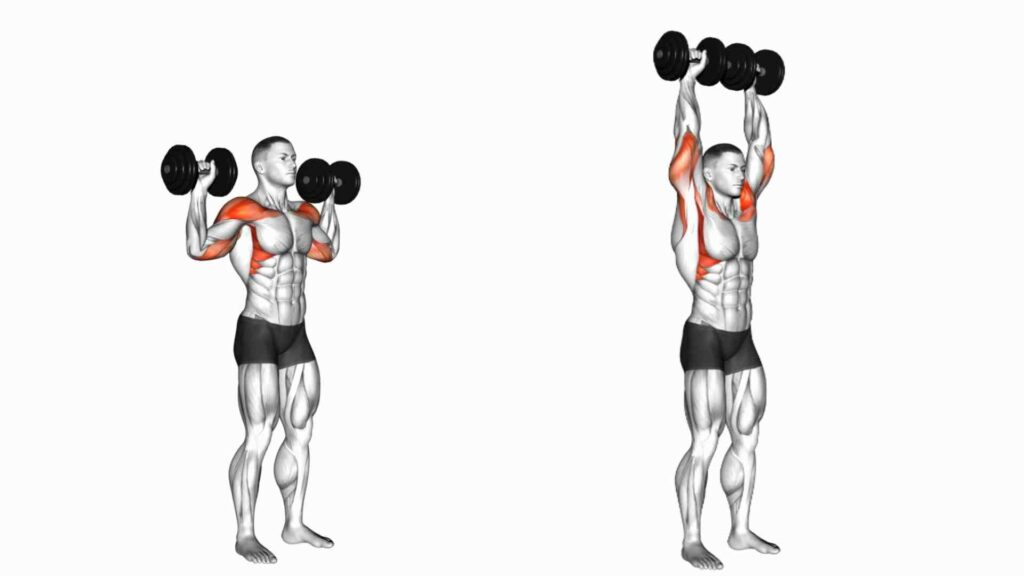
- Setup: Stand with your feet together, toes pointing forward. Grip the barbell with hands shoulder-width apart.
- Grip and Position: Keep your wrists straight and elbows directly under the bar. The bar should rest on your upper chest.
- Bracing: Engage your core and glutes to maintain a stable, upright posture.
- Pressing: Push the barbell straight overhead, keeping the bar path close to your face. Slightly tilt your head back as the bar passes, then bring it forward.
- Lockout: Fully extend your arms at the top, with the barbell over your shoulders. Avoid shrugging your shoulders.
- Lowering: Lower the barbell back to your upper chest in a controlled manner, maintaining a tight core.
Key Points:
- Maintain a neutral spine throughout the movement.
- The narrower stance increases the stability challenge, requiring more core engagement.
- Avoid excessive leaning or arching of the lower back.
- Use a full range of motion, pressing the bar overhead completely.
BMR and Daily Calorie Calculator
By following these guidelines, you can perform both the Overhead Press and Military Press safely and effectively, ensuring optimal muscle engagement and reducing the risk of injury.
Differences between Overhead Press and Military Press
Here are the key differences between the Overhead Press and the Military Press:
- Grip and Stance: Overhead Press typically performed with a wider grip and a more natural stance, allowing for a slight lean back. On the other hand, Military Press usually done with a narrower grip and a strict, upright posture, often requiring the feet to be together.
- Movement Pattern: Overhead Press involves a more vertical path, allowing some body movement, including a slight dip or arch in the lower back. On the other hand, Military Press requires a strict up-and-down motion with minimal body movement, focusing on strict form.
- Range of Motion: Overhead Press often allows for a greater range of motion as you may incorporate leg drive and hip movement. On the other hand, Military Press Emphasizes a more controlled motion with less emphasis on leg involvement.
- Muscle Activation: Overhead Press engages the shoulders, triceps, and upper chest but also recruits the legs and core for stability. On the other hand, Military Press Primarily targets the shoulders and triceps, with less emphasis on leg drive, focusing more on shoulder strength.
- Equipment Used: Overhead Press can be performed with a barbell, dumbbells, or kettlebells, and may include seated or standing variations. On the other hand, Military Press traditionally done with a barbell, often standing, emphasizing a more strict form.
- Purpose and Goals: Overhead Press great for overall shoulder development and functional strength; often included in bodybuilding and functional training. On the other hand, Military Press focused on building strength and power in the shoulders; commonly used in powerlifting and strength-focused programs.
SHOP FOR THE RESISTANCE BAND ON AMAZON
Understanding these differences can help you choose the right exercise based on your fitness goals and preferences.
Benefits of Each Exercise
The Overhead Press and the Military Press are both foundational exercises in strength training, each offering unique benefits. The Overhead Press is a compound movement that significantly strengthens the upper body and tests upper body stability. It’s particularly effective for building the deltoids and triceps, and it also engages the core muscles, which need to be strong to maintain proper form during the lift. This exercise can improve your posture and increase muscle activation and definition in the shoulders, triceps, and upper chest.
On the other hand, the Military Press, while similar to the Overhead Press, has some unique advantages. It’s a basic exercise that leads to other important weightlifting movements and significantly develops core strength. The Military Press can increase shoulder mobility and improve shoulder health. It also has an incredible carryover to the bench press, leading to high levels of core activation. Furthermore, it can remedy pushing imbalances and increase functional strength and muscle mass.
In conclusion, both exercises offer unique benefits and can be used to target different aspects of upper body strength and development.
Common Mistakes and How to Avoid Them
Let’s discuss some common mistakes made during the Overhead Press and the Military Press, and how to avoid them:
Overhead Press
- Incorrect Grip Width: This can impair overall success in the press. The grip should be set slightly wider than shoulder width, with vertical forearms and the elbows inline with the wrist.
- Wrists Are Too Bent: This can cause the barbell to slide down onto the upper chest. Ensure you have a full, firm grip on the barbell, with the wrist stacked.
- Not Pushing the Bar Vertically: This can lead to injury or poor results. Always push the bar directly upwards.
- Overarching the Lower Back: This can lead to lower back strain. Keep your core engaged and maintain a neutral spine.
- Flaring the Elbows: This puts undue stress on the shoulders. Keep elbows slightly in front of the bar.
Military Press
- Leg Drive: Using a drive from the legs to begin and assist the military press turns it into a push press. The Military Press should be a strict press without any leg drive.
- Body Lean: If body lean increases during the lift, it turns into a side press. A degree of body lean may be necessary, but it should not continue to increase as the lift continues.
- Pressing the Barbell Outwards: This is a common mistake made by both beginners and advanced users. Always press the barbell directly up and in line with your body.
- Not Locking Out Your Elbows at the Top of the Press: This can lead to poor results. Always lock out your elbows at the top of the press.
SHOP FOR THE SQUAT RACK ON AMAZON
Remember, proper form is key to performing these exercises effectively and safely. Always ensure proper form to effectively target these muscles and prevent injury.
Variations and Modifications
Let’s discuss some variations and modifications of the Overhead Press and the Military Press:
Overhead Press Variations
- Seated Overhead Press: Performed while seated to reduce lower back strain. Great for focusing on shoulder strength without the need for core stabilization.
- Single-Arm Overhead Press: Involves pressing with one arm, promoting unilateral strength and stability. Helps address imbalances between sides.
- Dumbbell Overhead Press: Using dumbbells instead of a barbell allows for a greater range of motion. Improves shoulder stability and engages more stabilizer muscles.
- Arnold Press: A variation where you rotate the dumbbells as you press up. Engages multiple shoulder muscles and adds variety to your routine.
- Push Press: Utilizes a slight leg drive to help propel the weight overhead. Useful for heavier lifts and increasing power.
Military Press Variations
- Standing Military Press: Performed standing with a barbell to engage the core and legs more actively. Enhances overall body stability while lifting.
- Strict Military Press: Focuses on pressing without any leg drive, emphasizing shoulder strength. Ideal for developing raw pressing power.
- Behind-the-Neck Press: Involves pressing the barbell from behind the neck to engage different shoulder angles. Requires good shoulder mobility and can be risky for some lifters.
- Kettlebell Military Press: Using kettlebells can change the dynamics of the lift and engage stabilizers differently. Promotes grip strength and shoulder stability.
- Z Press: Performed seated on the floor with legs extended, focusing solely on shoulder strength. Eliminates leg drive, emphasizing strict form and stability.
Modifications for Different Fitness Levels
- Beginner Modifications: Start with lighter weights or resistance bands to master form. Use seated variations to reduce the risk of injury and build confidence.
- Intermediate Modifications: Incorporate tempo training (slower movements) to enhance control and muscle engagement. Add progressive overload by gradually increasing weights.
- Advanced Modifications: Combine different variations in a single workout for added complexity (e.g., supersetting). Include advanced techniques like pause reps or eccentric training for muscle growth.
SHOP FOR THE WEIGHTLIFTING GLOVES ON AMAZON
By exploring these variations and modifications, you can keep your training fresh, target different muscle groups, and accommodate varying fitness levels.
When to Choose One Over the Other
Choosing between the Overhead Press and the Military Press depends on your fitness goals, experience level, and any existing physical conditions. Here are some Scenarios to choose one over the other;
When to Choose Overhead Press
- If your goal is to build overall shoulder strength and size, the Overhead Press is a great choice due to its compound nature and engagement of multiple muscle groups.
- The Overhead Press is often included in strength competitions. If you’re training specifically for powerlifting or Olympic lifting, this press can be more beneficial.
- If you’re recovering from a shoulder injury, the Overhead Press might be easier on the joints, especially if performed with a neutral grip or lighter weights.
- If you want to add variety to your routine and engage different stabilizing muscles, the Overhead Press can provide a different stimulus compared to more rigid movements like the Military Press.
When to Choose Military Press
- If your goal is to develop strict shoulder strength without involving the legs, the Military Press is ideal as it requires a more upright posture.
- For those in military or tactical roles, the Military Press mimics the strict press often required in functional training settings.
- If you’re focused specifically on upper body strength and want to isolate the shoulders more, the Military Press is a great option.
- In some strength programs, the Military Press is favored due to its focus on form and control, making it beneficial for developing discipline in pressing movements.
Combining Both
- Periodization: Consider incorporating both exercises in a structured periodization plan. Use the Overhead Press during strength-building phases and the Military Press during periods focusing on strict form.
- Training Goals: If you’re aiming for hypertrophy, you might alternate between both presses in different cycles to keep your training fresh and engaging.
By understanding these contexts, you can choose the right exercise based on your specific goals and training needs.
FAQs
Q 1. What equipment do I need for the Overhead Press and the Military Press?
Ans. You’ll need a barbell and a squat rack or power cage. Dumbbells can also be used for variations of these exercises.
Q 2. Can beginners start with the Military Press?
Ans. Yes, beginners can start with the Military Press, but it’s important to start with light weights and focus on proper form to avoid injury.
Q 3. How can I incorporate the Overhead Press and the Military Press into a full-body workout routine?
Ans. These exercises can be included in your upper body or shoulder workout days. They can also be part of a full-body workout routine, depending on your fitness goals.
Q 4. What are some common injuries associated with the Overhead Press and the Military Press, and how can they be prevented?
Ans. Common injuries include shoulder impingement and lower back strain. These can be prevented by using proper form, not lifting too heavy, and adequately warming up before the workout.
Q 5. How often should I perform the Overhead Press and the Military Press?
Ans. This depends on your workout routine and goals. Generally, performing these exercises 1-2 times per week can be beneficial for strength and muscle development.
Q 6. Can the Overhead Press and the Military Press be performed on the same day?
Ans. Yes, they can be performed on the same day. However, it’s important to monitor your body’s response and ensure you’re not overworking your muscles.
Q 7. Are there any alternatives to the Overhead Press and the Military Press for individuals with shoulder issues?
Ans. Yes, alternatives include the dumbbell shoulder press, lateral raises, or front raises. However, anyone with shoulder issues should consult with a healthcare professional before attempting new exercises.
Q 8. How do I know if I’m lifting too heavy on these exercises?
Ans. Signs of lifting too heavy include inability to maintain proper form, excessive straining, or pain during or after the exercise. It’s important to listen to your body and adjust the weight as needed.
Conclusion
In the debate between the Overhead Press and the Military Press, both exercises hold unique advantages that cater to different training goals. The Overhead Press is excellent for overall shoulder development and functional strength, making it a versatile choice for many lifters. On the other hand, the Military Press, with its strict form and emphasis on control, offers a more focused approach to building upper body power and stability.
Ultimately, the choice between the two should align with your personal fitness objectives and comfort level. Incorporating both exercises into your routine can provide a well-rounded shoulder workout that enhances strength and muscle growth. Remember to prioritize proper form, listen to your body, and enjoy the process of becoming stronger. Whether you prefer the dynamic nature of the Overhead Press or the disciplined approach of the Military Press, both can significantly contribute to your fitness journey.

Good day, and welcome to Fitthour. My name is Shubham Vijay, and I am a certified personal trainer and nutrition coach with 6 years of experience in the fitness industry. At Fitthour, we specialize in types of training, such as strength training, cardio, or HIIT, and our mission is to help clients achieve their fitness goals and improve their overall health.

